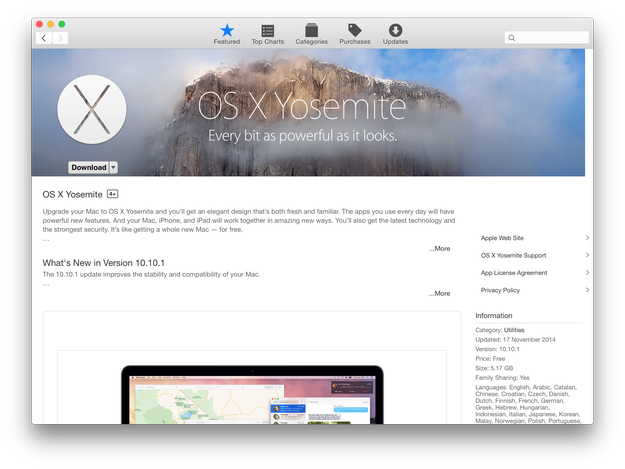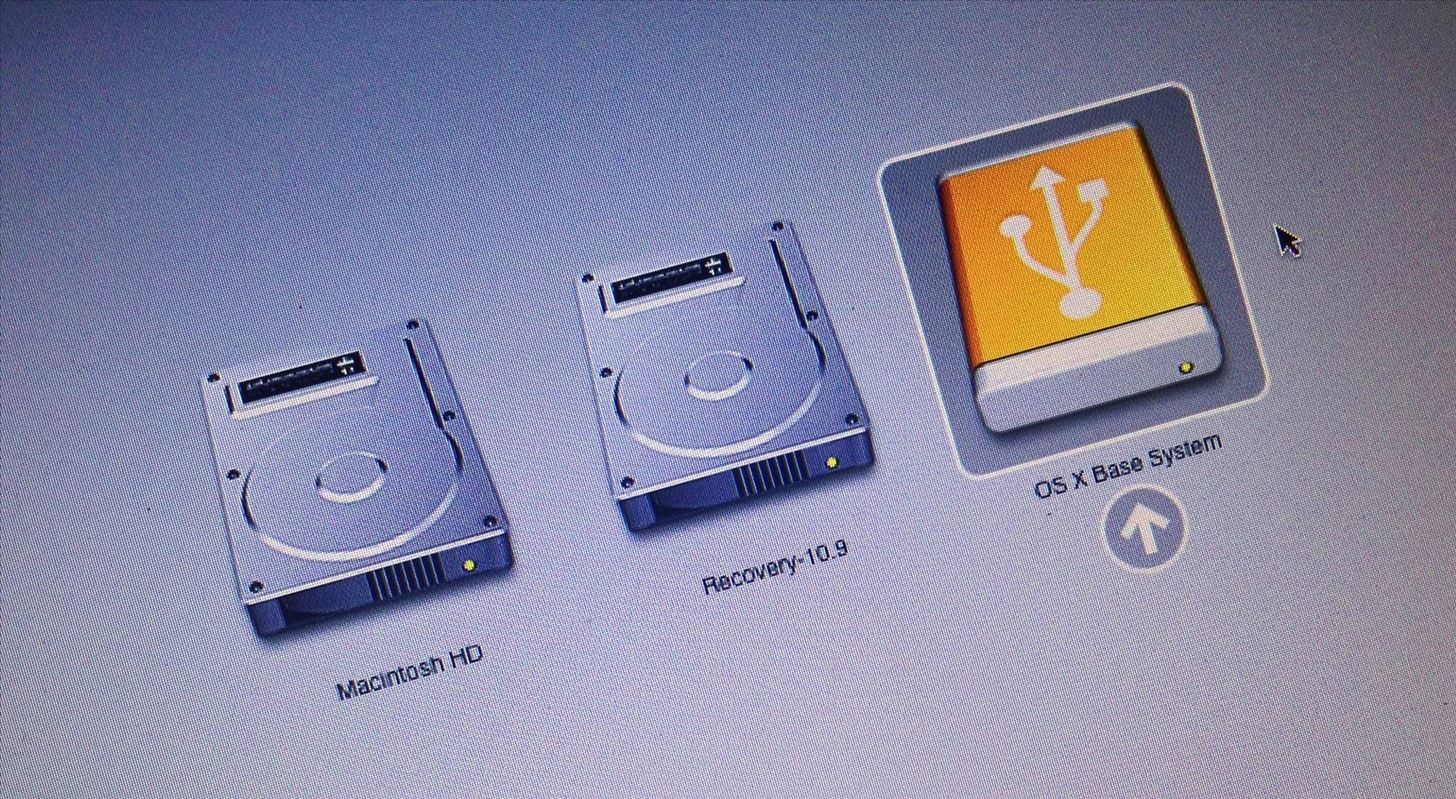| Name: | mac.os.x.yosemite.hackintosh.bootable.iso |
|---|---|
| Size: | 5.50 GB |
| Files | Yosemite_Hackintosh.iso (5.50 GB) |
- Create Windows 10 Bootable Usb
- Download Mac Os X Yosemite Bootable Usb
- Download Os X Yosemite Bootable Usb
- Download Yosemite Bootable Usb Free
The instructions I found that worked, using Disk Utility, were located at How to Make a Bootable OS X Mavericks USB Install Drive and How to Create a Bootable Install USB Drive of Mac OS X 10.10 Yosemite. Download the Mac OS X 10.10 Yosemite. First, download the latest Mac OS X version, which is 10.10 Yosemite. OS X Yosemite bootable USB. Step 1: First step is to download OS X Yosemite installation file. The download size is about 5.2 GB and can be downloaded by following the instructions in our how to download OS X Yosemite guide. Step 2: Next step is to download and install DiskMaker X app.
Description
Mac OS X – Yosmite (Hackintosh)
Mac OS X Yosemite Hackintosh
System Requirements: OS X Yosemite 10.10.1 (Build: 14B25) is compatible and supported by following computer hardware systems.
Intel Based Processors AMD Based Processors Installed on Windows Only i.e.(Windows 10,Windows 8.1, Windows 8, Windows 7, Windows Vista, Windows XP)
Minimum 2 GB of RAM
Minimum 8 GB of Hard Disk Drive (HDD)
Step 1: Download Hackintosh OS X 10.10.1 Yosemite .ISO File for Windows
Step 2: Mount the Hackintosh ISO Image File i.e. 10101usb.iso.
Step 3: Install R-Drive (in the hand).
Step 4: Now expand the image 10.10.1.usb.arc to any Bootable USB flash drive or Bootable DVD for manual installation.
Step 5: After that, Specified during installation to become the partition active.
Step 6: Now, reboot, load with flash to make Mac OS X installation.
Step 7: When installation gets complete, reboot again with the USB stick or DVD, but choose a boot menu section with a freshly installed Mac OS X Yosemite.
Step 8: Now, after download completes successfully – install the boot loader and the necessary kekstov. Congratulations!! You’re done
These advanced steps are primarily for system administrators and others who are familiar with the command line. You don't need a bootable installer to upgrade macOS or reinstall macOS, but it can be useful when you want to install on multiple computers without downloading the installer each time.
- D) Download OS X 10.10 Yosemite Final from the Mac App Store and save it to the Applications folder – its default location. How to Create Bootable USB Flash Drive. First, create bootable USB flash drive. Here is how you do it, courtesy of Redmond Pie: Plug in your USB drive into the computer and open Disk Utility (in Applications).
- Dear Hackintosh Expert, I had download a Yosemite-zone.dmg and restore it into an USB by transmac and make it bootable in most PC desktop. I installed it into a Lenovo M57 desktop amd it works fine.( Sound card, video, LAN Card & even USB WiFi card) I then try to install it into my new laptop and the nightmare had started.
What you need to create a bootable installer
- A USB flash drive or other secondary volume formatted as Mac OS Extended, with at least 14 GB of available storage
- A downloaded installer for macOS Big Sur, Catalina, Mojave, High Sierra or El Capitan
Download macOS

- Download: macOS Big Sur, macOS Catalina, macOS Mojave or macOS High Sierra
These will be downloaded to your Applications folder as an app named Install macOS [version name]. If the installer opens after downloading, quit it without continuing installation. To get the correct installer, download from a Mac that is using macOS Sierra 10.12.5 or later, or El Capitan 10.11.6. Enterprise administrators, please download from Apple, not a locally hosted software-update server. - Download: OS X El Capitan
This will be downloaded as a disk image named InstallMacOSX.dmg. On a Mac that is compatible with El Capitan, open the disk image and run the installer within, named InstallMacOSX.pkg. It will install an app named Install OS X El Capitan into your Applications folder. You will create the bootable installer from this app, not from the disk image or .pkg installer.
Use the 'createinstallmedia' command in Terminal
- Connect the USB flash drive or other volume that you're using for the bootable installer.
- Open Terminal, which is in the Utilities folder of your Applications folder.
- Type or paste one of the following commands in Terminal. These assume that the installer is in your Applications folder and MyVolume is the name of the USB flash drive or other volume you're using. If it has a different name, replace
MyVolumein these commands with the name of your volume.
Big Sur:*
Catalina:*
Mojave:*
Create Windows 10 Bootable Usb
High Sierra:*
El Capitan:
* If your Mac is using macOS Sierra or earlier, include the --applicationpath argument and installer path, similar to the way this is done in the command for El Capitan.
After typing the command:

- Press Return to enter the command.
- When prompted, type your administrator password and press Return again. Terminal doesn't show any characters as you type your password.
- When prompted, type
Yto confirm that you want to erase the volume, then press Return. Terminal shows the progress as the volume is erased. - After the volume has been erased, you may see an alert stating that Terminal would like to access files on a removable volume. Click OK to allow the copy to proceed.
- When Terminal says that it's been completed, the volume will have the same name as the installer you downloaded, such as Install macOS Big Sur. You can now quit Terminal and eject the volume.
Use the bootable installer
Determine whether you're using a Mac with Apple silicon, then follow the appropriate steps:
Apple silicon
- Plug the bootable installer into a Mac that is connected to the internet and compatible with the version of macOS you're installing.
- Turn on your Mac and continue to hold the power button until you see the startup options window, which shows your bootable volumes.
- Select the volume containing the bootable installer, then click Continue.
- When the macOS installer opens, follow the onscreen instructions.

Download Mac Os X Yosemite Bootable Usb
Intel processor
- Plug the bootable installer into a Mac that is connected to the internet and compatible with the version of macOS you're installing.
- Press and hold the Option (Alt) ⌥ key immediately after turning on or restarting your Mac.
- Release the Option key when you see a dark screen showing your bootable volumes.
- Select the volume containing the bootable installer. Then click the up arrow or press Return.
If you can't start up from the bootable installer, make sure the External Boot setting in Startup Security Utility is set to allow booting from external media. - Choose your language, if prompted.
- Select Install macOS (or Install OS X) from the Utilities window, then click Continue and follow the onscreen instructions.
Learn more
Download Os X Yosemite Bootable Usb
A bootable installer doesn't download macOS from the internet, but it does require an internet connection to get firmware and other information specific to the Mac model.
Download Yosemite Bootable Usb Free
For information about the createinstallmedia command and the arguments you can use with it, make sure the macOS installer is in your Applications folder, then enter the appropriate path in Terminal:



